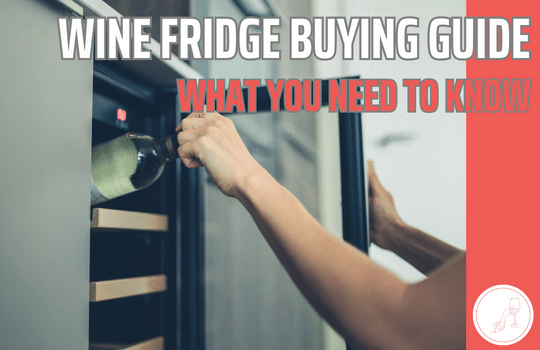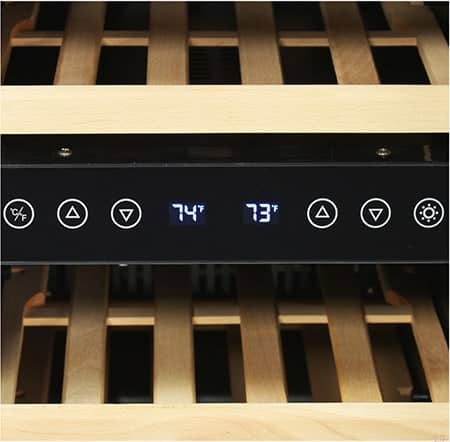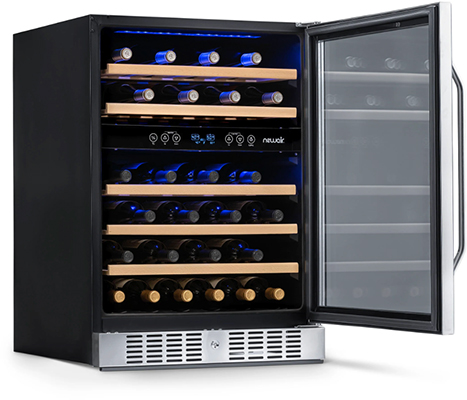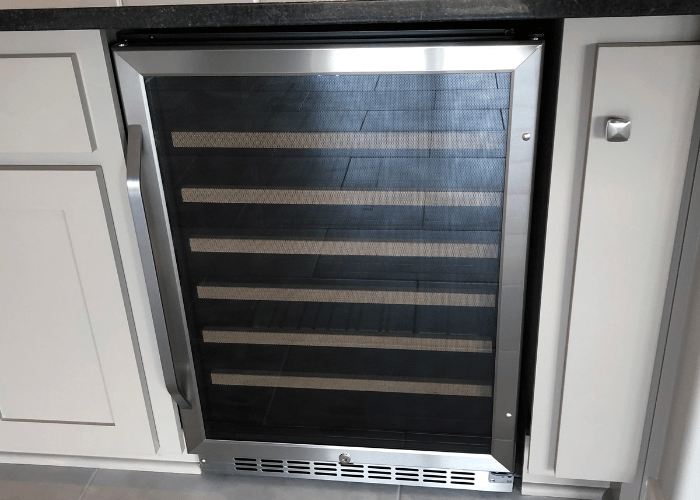Wine Refrigerator Buying Guide | What You Need to Know

I've bought a few wine refrigerators over the years and it can be a confusing leap into the unknown.
Wine fridges come in a variety of shapes, sizes, styles, and types.
To ensure you get the perfect wine refrigerator for your home, you should have some details firmly in mind before you start shopping.
So, what do you need to know and where should you start?
Step 1: Do you need a single-zone or dual-zone wine fridge?
Wine fridges are available with single-zone or dual-zone temperature zones.
That means you can have one consistent temperature throughout your fridge (single-zone) or two separate temperature compartments (dual-zone).
A single-zone wine fridge is best chosen if you only have one aim.
That aim could be one of the following:
A dual-zone wine refrigerator is much more versatile and gives you the option to do both.
A dual-zone wine refrigerator can perform two roles. It can:

A dual-zone fridge with 2 independent temperature controls
To recap:
Single temperature zone - choose this if you are only interested in serving reds or whites. Also, if you only plan on keeping your wines at storage temperature.
Dual temperature zone - choose this if you have a varied wine collection or if you are planning on having one. You can keep both reds and whites ready at serving temperature. If you entertain guests regularly then a dual zone fridge is probably the right choice.
Step 2: How many bottles do you need to store?
Wine fridges are sized according to the number of bottles they can hold.
The smallest wine fridges actually start out at just 6 bottles which is around the size of a small beer fridge, while the biggest models can hold upwards of 100 bottles.
The decision you need to make is whether you intend on collecting wine to age or if you just need a good selection for short-term consumption.
If it's the previous, you'll want to leave plenty of room for growth and you'll also likely want a dual-zone wine refrigerator (see the previous section).
So, think about your current and future wine buying habits.
How much wine do you buy?
Do you intend on growing a collection of wine?
Step 3: Where will you install your wine fridge?
Another distinction made with wine coolers is how they are installed.
They're available as what's called:
Built-in units - these are custom fitted into your kitchen cabinetry.
Freestanding units - these can be placed wherever there is space.
It's important that you don't try and fit a freestanding unit into a built-in space as they have a vent at the back.
Blocking this vent will cause the compressor to work too hard and eventually fail.
Built-in units solve this problem by having the vent at the front. They are the most compact and tight fitting choice because they have the venting at the front and don't require a small gap at the back.
The necessary clearance distances to nearby walls and surfaces is much less for a built-in wine fridge.
But, not everyone has the luxury of redesigning their kitchen cabinetry.
Freestanding units offer versatility by the fact they can be moved quite easily (depending on the size!).
The great thing about the new wave of wine coolers is that they come in narrow and compact sizes to save as much space as possible.
Some freestanding wine cooler now offer venting at the front too. This is a great option to have if you can't afford that inch or two of wall clearance at the back.
Undercounter wine coolers that slide under built-in counters are also usually front vented.

A front vented 'built-in' wine fridge
Wine Fridge Installation Site: Important Points to Consider
1. Keep it out of direct sunlight - even though most wine fridges have UV filtering glass, direct sunlight is going to heat the fridge unnecessarily. This is going to cause your cooler to work harder to maintain the desired temperature. This is bad for the compressor and bad for your electric bills!
2. It should be within 6 feet of a power supply - a powerful appliance like this shouldn't use an extension cord so we want to be within about 6 feet of power.
3. It should be away from sources of excessive vibration - vibrations are bad for wine. They unsettle the sediment and can even kickstart chemically altering reactions within the wine that affect its flavor and composition.
Step 4: How much money are you willing to spend?
Obviously the price increases with the size of a wine cooler but what other factors affect its cost?
Which features are worth paying extra for and are there any that you can do without?
Here's the lowdown on the special features that affect the cost of a wine fridge.
Dual Temperature Zones - dual-zone wine fridges are unsurprisingly more expensive than single-zone models. A dual zone wine fridge allows two different temperatures to be set.
This allows you to store both reds and whites at serving temperature or to keep wine at both storage temperature and serving temperature.
This versatility in design comes at a price as you have two thermostats that need controlled by two cooling systems.

Built-in wine fridge installed under the kitchen counter
Low Noise/Low Vibrations - compressors are by their very nature, quite noisy. That buzz that your food fridge makes is made by the compressor doing the cooling.
Thankfully, wine fridge compressors are generally a quiet bunch but they're not silent. The quietest wine coolers usually demand the higher prices.
You're looking at anything below 45 dB as being pretty quiet when it comes to noise output.
In the last few years, thermoelectric wine fridges have been becoming increasingly popular. They are much quieter and more energy efficient than traditional compressors.
However, they have a few drawbacks.
They don't cool as powerfully as compressors so they aren't best suited to very hot climates. Their cooling performance is relative to the ambient temperature, so in very hot weather they might not be able to lower the temperature low enough for your wine.
They're also not ideal for large wine fridges. Though this is changing as thermoelectric technology improves over time.
One final benefit that thermoelectric coolers have over compressor based systems is that there is no vibration. Compressors tend to do a fair bit of vibrating while they cool (though the compressors of good wine fridges create minimal vibrations).
Vibrations are bad for a few reasons. They unsettle the sediment and spread it throughout the wine. Vibrations can also cause chemical reactions in the wine that affect the flavor and aroma.
I've listed the pros and cons of thermoelectric cooling vs compressor based cooling in the table below.
Pros | Cons |
|---|---|
Quieter than compressors | Not as powerful |
More energy efficient | Only suitable for small fridges |
No vibration |
Warranty - if you're spending a lot of money on an appliance to keep what could be quite an expensive wine collection safe, then you want to have some piece of mind right?
The best wine coolers come with solid warranties that protect your consumer rights incase something should go wrong.
If a solid warranty isn't included in the price then adding an additional policy isn't a bad idea that could well be worth it in the long run.
Is it Lockable? - this ones really important if you have kids in the house and also if you have an expensive wine collection that you'd like to offer another layer of protection.
Not all wine fridges are lockable but plenty are. They usually use a key system and most will come with two sets of keys.
Glass Thickness - generally the thicker the glass door the more expensive the wine cooler.
The best wine fridges use at least double glazed glass but sometimes triple thickness glass. This is to help with heat insulation (keep the cool air inside and the warm air outside) and therefore the energy efficiency.
UV Filtration - ultra violet light (found in sunlight) can be incredibly harmful to wine. Over time a wine that is exposed to UV light will age prematurely.
Thankfully, most good wine coolers use UV resistant glass coatings so this isn't something you need to worry about.
This is also why wine coolers use interior LED lighting. LED lights only emit a tiny fraction of the UV light and heat (which is also damaging to wine) that other light sources do.
Air Filter - the really high quality wine coolers come with air filters. If exposed to strong odors in the air for long enough, wines will absorb them through the cork.
To protect your wine collection, some refrigerators come with activated carbon air filters that neutralize strong odors and protect your wine collection.
What are the Advantages of a Wine Cooler?
Is a wine cooler even necessary? Will a regular fridge not be enough?
These are the main reasons you might want to look at upgrading your wine storage.
Still have questions? Leave a comment down below and I'll get right back to you!
